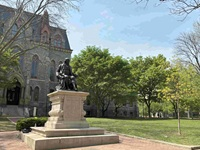Speaker
Description
Amorphous selenium (a-Se) has become of high interest in detectors for high-
energy physics due to its versatility in application. It exhibits a number of ideal
properties, including a low threshold field for impact ionization (<70 Vμm), high
photoconversion efficiency over a broad range of frequencies, and the capability
for uniform large area fabrication. A-Se can be fabricated on a variety of sub-
strates and readout systems with minimal pos-fabrication processing, and can
be integrated onto CMOS chips as a hybrid detector, which will allow for large
area camera development by tiling. Many of the optical and electrical proper-
ties of a-Se can be tuned through alloying and doping, providing even greater
control over the detector for specific applications. The Radiological Instrumen-
tation Laboratory has recently reported on our investigations of alloying with
type IV and VI semiconductors, demonstrating improved sensitivity in green
to near-infrared wavelengths. However, precise control of the alloy composition
and the inclusion of elements that have significantly different melting points
requires the co-deposition of materials from multiple sources during thermal
evaporation. In this work, we present our first studies on films fabricated from
our newly installed co-deposition system and discuss how we can continue to
tune the photoconversion layer to improve detector properties.

